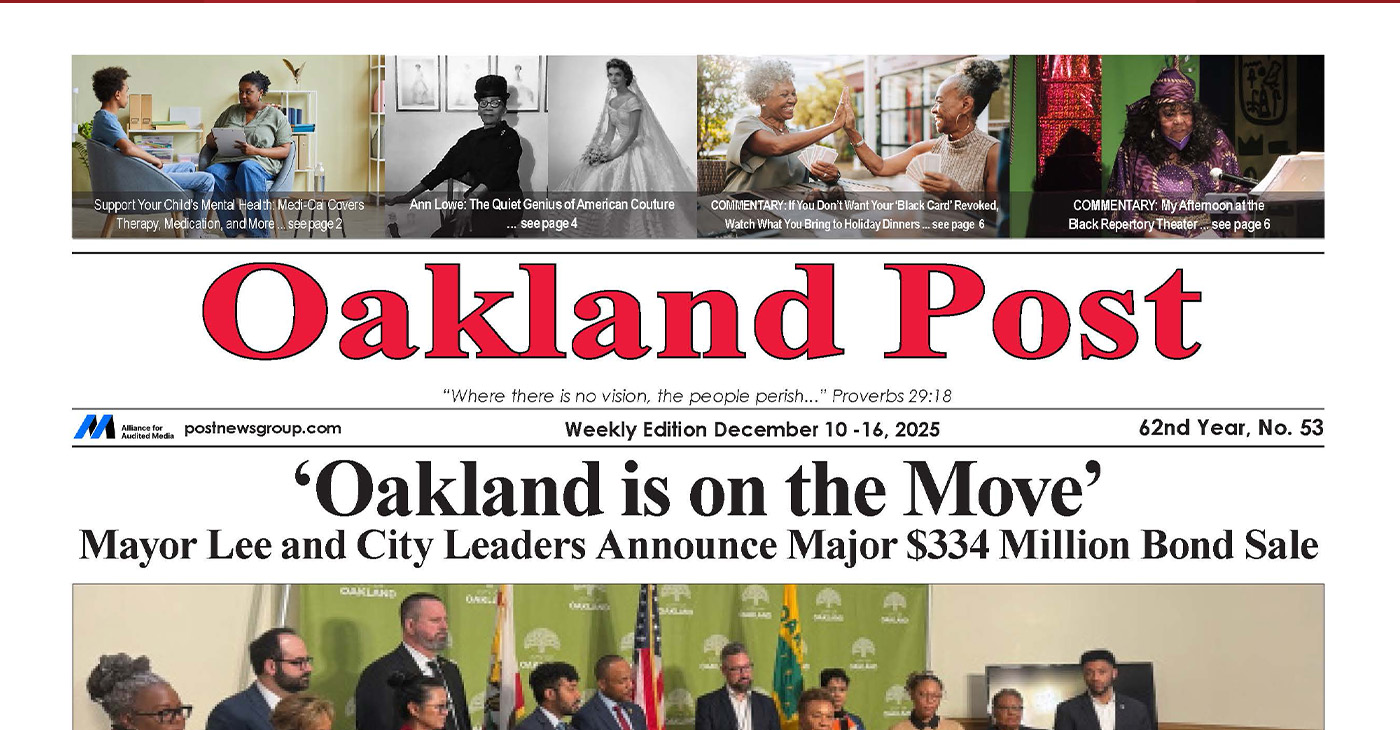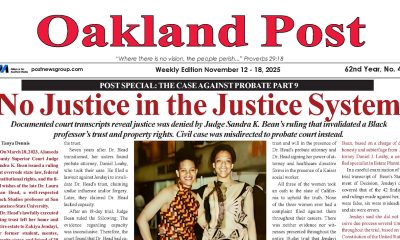National
Blacks Now Finishing High School at Record Levels

In this May 5, 2014 photo, Krishaun Branch, left, moves the tassel on his mortarboard to the left side after graduating from Fisk University in Nashville, Tenn. (AP Photo/Mark Humphrey)
By Jazelle Hunt
NNPA Washington Correspondent
WASHINGTON (NNPA) – After 30 years of little to no progress, Black youth are completing high school at the highest rates in history.
This is the finding in a new issue brief titled, “Young Black America Part One: High School Completion Rates are at their Highest Ever,” published by the Center for Economic Policy Research, a Washington-based think-tank. The report examines Census Bureau data for 20 to 24 year-olds, and compares high school completion rates around the country over the past 30 to 40 years.
“All in all, young blacks have experienced significant gains in high school completion rates during the past 13 years,” the report reads. “Given the importance of educational attainment in determining future wages, higher completion rates should, in theory, translate to higher wages.”
In 1975, Black Americans finished high school at a 75 percent rate, compared to 88 percent for Whites and the overall 86 percent rate. In 2000, Blacks completed high school at a 14 percent lower rate than their White counterparts. However, by 2013, the Black completion rate rose to 86 percent, its highest-ever level, shrinking the Black-White gap to less than 7 percent.
“I’m a young Black woman and I wanted to answer the question of what’s going on with young Blacks in America,” says Cherrie Bucknor, a Center for Economic Policy Research assistant and author of the paper. “Sometimes there are too many negative portrayals and negative stereotypes on young Blacks, and I like the fact this was something positive to focus on.”
The gender break down also shows a noteworthy trajectory. In addition to slightly outpacing the rate for Black boys (a trend that holds for all girls, across race), the completion rate for Black girls is 89 percent, only five points lower than the rate for White girls.
While the gains of Black girls were more gradual, Black boys have experienced a rocky road to improvement in helping close the Black-White high school completion gap.
“The completion rate for black males followed the same trajectory, but 3 to 8 percentage points lower. Although black males experienced noticeable gains in completion rates during this century (an increase of 18.1 percent since 2000), their gains were not enough to offset the gains of other groups, leaving noticeable gaps in completion rates between black males and other groups,” the report stated.
“In 2013, the completion rate for black males (83.5 percent) was 5.9 percentage points lower than black females and 8.8 percentage points lower than white males.”
Regional analysis also shows a different trend. At 10 percent higher than the national rate for Black students, the West has held the most promise for Black students since 1975. But the other regions have caught up in recent years. As of 2013, Black students in both the Northeast and the West have the highest completion rates (88.2 and 88.1 percent, respectively). Further, all of the regions now have comparable rates for Black students, all within three percentage points of one another.
Although the report does not examine or speculate on causes for this breaks in these trends, Bucknor has a few theories.
“One factor that might be in play is increasing the graduation requirements for students in general, which makes the decision to drop out or stay in school a little bit different than before then,” Bucknor explains, adding that test scores for entering freshmen also been improving. “And since 2000, some of the plausible factors that I’ve read about include declining teenage birth rates…[which] makes them more likely to be in school.”
The teenage birth rate is also at a historic low, particularly for Black teens. According to 2012 data from the National Center for Health Statistics, the maternity rate for Black girls age 15 to 17 has dropped 45 percent since 2000; for 18 and 19-year olds it has dropped 30 percent.
This report is the first part in a series that explores measures of success (or lack thereof) among Black people under 40.
“I feel like there’s a lot of attention on Blacks in general, but I wanted to focus on young Blacks like me,” Bucknor says. “So I’m hoping to look at several issues related to education, jobs, and inequality as a way to answer that question.”
###
Activism
Oakland Post: Week of December 10 – 16, 2025
The printed Weekly Edition of the Oakland Post: Week of – December 10 – 16, 2025

To enlarge your view of this issue, use the slider, magnifying glass icon or full page icon in the lower right corner of the browser window.
Alameda County
Seth Curry Makes Impressive Debut with the Golden State Warriors
Seth looked comfortable in his new uniform, seamlessly fitting into the Warriors’ offensive and defensive system. He finished the night with an impressive 14 points, becoming one of the team’s top scorers for the game. Seth’s points came in a variety of ways – floaters, spot-up three-pointers, mid-range jumpers, and a handful of aggressive drives that kept the Oklahoma City Thunder defense on its heels.

By Y’Anad Burrell
Tuesday night was anything but ordinary for fans in San Francisco as Seth Curry made his highly anticipated debut as a new member of the Golden State Warriors. Seth didn’t disappoint, delivering a performance that not only showcased his scoring ability but also demonstrated his added value to the team.
At 35, the 12-year NBA veteran on Monday signed a contract to play with the Warriors for the rest of the season.
Seth looked comfortable in his new uniform, seamlessly fitting into the Warriors’ offensive and defensive system. He finished the night with an impressive 14 points, becoming one of the team’s top scorers for the game. Seth’s points came in a variety of ways – floaters, spot-up three-pointers, mid-range jumpers, and a handful of aggressive drives that kept the Oklahoma City Thunder defense on its heels.
One of the most memorable moments of the evening came before Seth even scored his first points. As he checked into the game, the Chase Center erupted into applause, with fans rising to their feet to give the newest Warrior a standing ovation.
The crowd’s reaction was a testament not only to Seth’s reputation as a sharpshooter but also to the excitement he brings to the Warriors. It was clear that fans quickly embraced Seth as one of their own, eager to see what he could bring to the team’s championship aspirations.
Warriors’ superstar Steph Curry – Seth’s brother – did not play due to an injury. One could only imagine what it would be like if the Curry brothers were on the court together. Magic in the making.
Seth’s debut proved to be a turning point for the Warriors. Not only did he contribute on the scoreboard, but he also brought a sense of confidence and composure to the floor.
While their loss last night, OKC 124 – GSW 112, Seth’s impact was a game-changer and there’s more yet to come. Beyond statistics, it was clear that Seth’s presence elevated the team’s performance, giving the Warriors a new force as they look to make a deep playoff run.
#NNPA BlackPress
LIHEAP Funds Released After Weeks of Delay as States and the District Rush to Protect Households from the Cold
BLACKPRESSUSA NEWSWIRE — The federal government has released $3.6 billion in home heating assistance after a delay that left states preparing for the start of winter without the program’s annual funding.

By Stacy M. Brown
Black Press USA Senior National Correspondent
The federal government has released $3.6 billion in home heating assistance after a delay that left states preparing for the start of winter without the program’s annual funding. The Low-Income Home Energy Assistance Program, known as LIHEAP, helps eligible households pay heating and cooling bills. The release follows a shutdown that stretched 43 days and pushed agencies across the country to warn families of possible disruptions.
State officials in Minnesota, Kansas, New York, and Pennsylvania had already issued alerts that the delay could slow the processing of applications or force families to wait until December for help. In Pennsylvania, more than 300,000 households depend on the program each year. Minnesota officials noted that older adults, young children, and people with disabilities face the highest risk as temperatures fall.
The delay also raised concerns among advocates who track household debt tied to rising utility costs. National Energy Assistance Directors Association Executive Director Mark Wolfe said the funds were “essential and long overdue” and added that high arrearages and increased energy prices have strained families seeking help.
Some states faced additional pressure when other services were affected by the shutdown. According to data reviewed by national energy advocates, roughly 68 percent of LIHEAP households also receive nutrition assistance, and the freeze in multiple programs increased the financial burden on low-income residents. Wolfe said families were placed in “an even more precarious situation than usual” as the shutdown stretched into November.
In Maryland, lawmakers urged the Trump administration to release funds after the state recorded its first cold-related death of the season. The Maryland Department of Health reported that a man in his 30s was found outdoors in Frederick County when temperatures dropped. Last winter, the state documented 75 cold-related deaths, the highest number in five years. Rep Kweisi Mfume joined more than 100 House members calling for immediate federal action and said LIHEAP “is not a luxury” for the 100,000 Maryland households that rely on it. He added that seniors and veterans would be placed at risk if the program remained stalled.
Maryland Gov. Wes Moore used $10.1 million in state funds to keep benefits moving, but noted that states cannot routinely replace federal dollars. His administration said families that rely on medical equipment requiring electricity are particularly vulnerable.
The District of Columbia has already mapped out its FY26 LIHEAP structure in documents filed with the federal government. The District’s plan shows that heating assistance, cooling assistance, weatherization, and year-round crisis assistance operate from October 1 through September 30. The District allocates 50 percent of its LIHEAP funds to heating assistance, 10 percent to cooling, 13 percent to year-round crisis assistance, 15 percent to weatherization, and 10 percent to administrative costs. Two percent is used for services that help residents reduce energy needs, including education on reading utility bills and identifying energy waste.
The District’s plan lists a minimum LIHEAP benefit of $200 and a maximum of $1,800 for both heating and cooling assistance. Crisis benefits are provided separately and may reach up to $500 when needed to resolve an emergency. The plan states that a household is considered in crisis if it has been disconnected from energy service, if heating oil is at 5 percent or less of capacity, or if the household has at least $200 owed after the regular benefit is applied.
The District’s filing notes that LIHEAP staff conduct outreach through community meetings, senior housing sites, Advisory Neighborhood Commissions, social media, posters, and mass mailings. The plan confirms that LIHEAP applicants can apply in person, by mail, by email, or through a mobile-friendly online application and that physically disabled residents may request in-home visits.
As agencies nationwide begin distributing the newly released funds, states continue working through large volumes of applications. Wolfe said LIHEAP administrators “have been notified that the award letters have gone out and the states can begin to draw down the funds.”
-

 Activism4 weeks ago
Activism4 weeks agoOakland Post: Week of November 12 – 18, 2025
-

 Activism3 weeks ago
Activism3 weeks agoIN MEMORIAM: William ‘Bill’ Patterson, 94
-

 Activism4 weeks ago
Activism4 weeks agoHow Charles R. Drew University Navigated More Than $20 Million in Fed Cuts – Still Prioritizing Students and Community Health
-

 Bay Area4 weeks ago
Bay Area4 weeks agoNo Justice in the Justice System
-

 #NNPA BlackPress3 weeks ago
#NNPA BlackPress3 weeks agoBeyoncé and Jay-Z make rare public appearance with Lewis Hamilton at Las Vegas Grand Prix
-

 #NNPA BlackPress3 weeks ago
#NNPA BlackPress3 weeks agoLewis Hamilton set to start LAST in Saturday Night’s Las Vegas Grand Prix
-

 Activism3 weeks ago
Activism3 weeks agoOakland Post: Week of November 19 – 25, 2025
-

 #NNPA BlackPress4 weeks ago
#NNPA BlackPress4 weeks agoThe Perfumed Hand of Hypocrisy: Trump Hosted Former Terror Suspect While America Condemns a Muslim Mayor












































